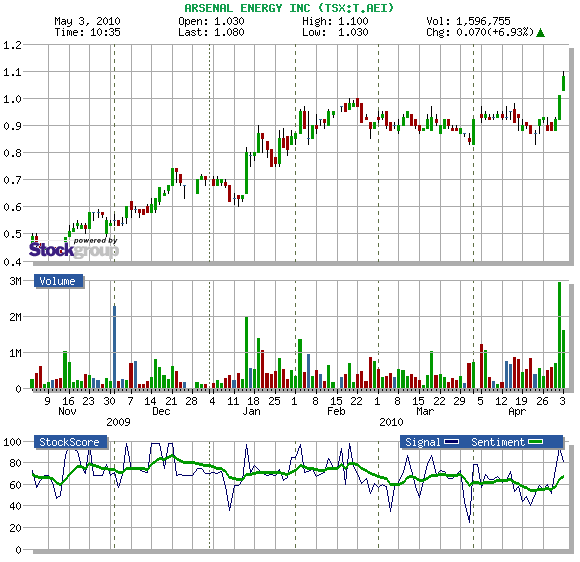Stockscores.com Perspectives for the week ending May 3, 2010
In this week’s issue:
Weekly Commentary
Strategy of the Week
Stocks That Meet The Featured Strategy
![]()
Over the past couple of months, I have taught a number of people how to trade through the Stockscores Live Trading classes. Over the course of three days, students learn the components of chart patterns, how to put those components together to find the most predictive chart patterns, risk management, rules for entry and exit, the processes for identifying trades and how to put it all together to trade well. We spend a lot of time looking at charts and, on the final day, I actually look for and execute real trades so that all the pieces can come together in to something meaningful.
These classes give attendees every rule that I follow in my own trading. The content is the product of my 20 years of trading through trial and error. I encourage my students to not seek out other methods after the leave the class because I just don’t think they need to do anything more than what I have taught them. The course content is complete.
This is not to say that there are not other ways to trade the market. There are probably thousands of ways to trade stocks and it is possible to come up with new ways by going through the same process that I go through when I am developing new strategies. However, I have found that there are also a lot of bad ways to trade the market and most people don’t like to put in the time and effort to develop their own method to trade with.
When the class is over, I would say that my students feel a great sense of optimism although this may be countered with a feeling of being overwhelmed. There is a lot of information in these classes and for those who are early in the process of learning about trading, it is a lot to take in.
Taking one of my trading classes will not make anyone a successful trader. It is a good step toward that goal and one that will save the aspiring trader a lot of time and money. However, there are other things that need to be done in order to get to the point of trading success. Whether you have taken one of my classes or learned how to trade somewhere else, there are things that you need to do in order to be successful.
- Get the StockSchool Pro Free
DisnatDirect named the number one Canadian brokerage for Traders by Surviscor! Open and Fund a brokerage account with DisnatDirect and receive the StockSchool Pro home study course free, including special Pro level access through the DisnatDirect client website. Offer only available to Canadian residents. For information, click HERE
- Get the StockSchool Pro Free
First, each student needs to go back to each individual trading skill and make sure that they understand it. The tendency is to start with the final result, which is to try and buy stocks breaking from a good chart pattern. However, there are many different skills that go in to that simple statement. What makes a good chart pattern? How do you manage risk? Each of these components can also be broken down in to many other skills.
I teach my class in small pieces and I am sure that most other trading approaches can be broken down in to small pieces as well. It is much easier to learn something when you take it one small, manageable component at a time.
Consider learning to play a song on the piano. A student who tries to play the song from start to finish after seeing someone do it once will fail. However, if they learn it one note a time, never moving on to the next note until the prior notes are learned, the learning process is simple. Learning the first note is easy, moving on to two notes and then three and four is also pretty simple. As long as you never move to the next note in the song until you have the notes before it learned, you will build up the muscle memory to make playing the whole song possible.
The same is true for trading. First learn inflection points, then use that to move on to support and resistance. Then optimism and pessimism and onward to the other components of chart patterns. As long as you go through each component one at a time and never move to the next until you understand the precedents, you will be able to read chart patterns. If you rush ahead and try to pick chart patterns without understanding each component first, you will have trouble.
Trading is simple as long as you give yourself the time to learn the basics first. Never move on to a new skill until you have its components skills understood. While this may seem like a tedious way to get to your goal, it will actually be the quickest way to success as you won’t waste time trying to do something that you don’t fully understand.
At the end of every class I teach, I always stress the importance of practice. Yes, you can learn the rules of trading in just a few days. However, every student has practice to do. There is no replacement for doing a skill over and over again until you get to the point that you don’t have to think about it, that it becomes natural. Nothing is easy until you practice it.
Have you ever noticed how people who are good at something make it look easy? How do you think they get to that point? If you have a good set of basic skills, the only other things you need are time and effort. Take your journey to trading mastery one step at a time. If you try to fly, you will only crash and burn.
![]()
The Stockscores Simple strategy uses the Stockscores indicators to identify stocks that may have predictive chart patterns. I run the Stockscores Simple Market Scan on Stockscores.com and then inspect the charts to see whether the stocks are making breaks from the right kind of chart pattern. I like to see stocks showing abnormal activity out of a period of quiet, sideways trading.
This week, I ran the Stockscores Simple Market Scan on the Canadian exchanges since they seem to be holding up better than the US markets. I found one stock that has the kind of price pattern that I look for.
![]()
1. T.AEI
T.AEI has been trading in a narrow, sideways trading range since mid February. On Friday, it broke to the upside with strong volume support. This means the stock has a good probability that it will move higher in the weeks to come. Support at $0.88.

References
Get the Stockscore on any of over 20,000 North American stocks.
Background on the theories used by Stockscores.
Strategies that can help you find new opportunities.
Scan the market using extensive filter criteria.
Build a portfolio of stocks and view a slide show of their charts.
See which sectors are leading the market, and their components.
Click HERE for the Speaker Lineup and to Purchase the video if you want to learn from some of the worlds best traders including Tyler Bollhorn.
Tyler Bollhorn started trading the stock market with $3,000 in capital, some borrowed from his credit card, when he was just 19 years old. As he worked through the Business program at the University of Calgary, he constantly followed the market and traded stocks. Upon graduation, he could not shake his addiction to the market, and so he continued to trade and study the market by day, while working as a DJ at night. From his 600 square foot basement suite that he shared with his brother, Mr. Bollhorn pursued his dream of making his living buying and selling stocks.
Slowly, he began to learn how the market works, and more importantly, how to consistently make money from it. He realized that the stock market is not fair, and that a small group of people make most of the money while the general public suffers. Eventually, he found some of the key ingredients to success, and turned $30,000 in to half a million dollars in only 3 months. His career as a stock trader had finally flourished.
Much of Mr Bollhorn’s work was pioneering, so he had to create his own tools to identify opportunities. With a vision of making the research process simpler and more effective, he created the Stockscores Approach to trading, and partnered with Stockgroup in the creation of the Stockscores.com web site. He found that he enjoyed teaching others how the market works almost as much as trading it, and he has since taught hundreds of traders how to apply the Stockscores Approach to the market.
Disclaimer
This is not an investment advisory, and should not be used to make investment decisions. Information in Stockscores Perspectives is often opinionated and should be considered for information purposes only. No stock exchange anywhere has approved or disapproved of the information contained herein. There is no express or implied solicitation to buy or sell securities. The writers and editors of Perspectives may have positions in the stocks discussed above and may trade in the stocks mentioned. Don’t consider buying or selling any stock without conducting your own due diligence.



